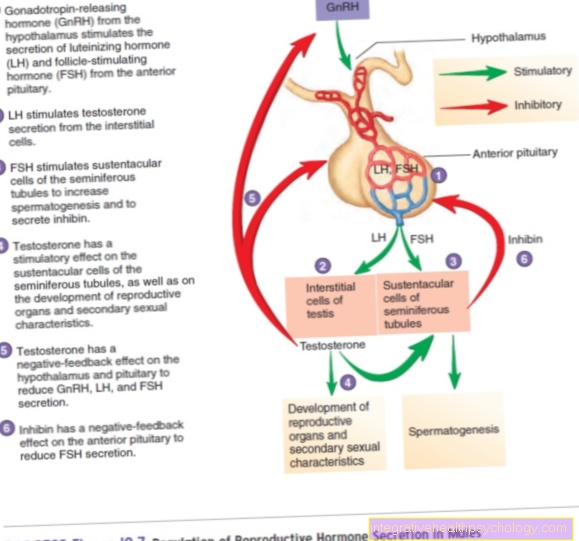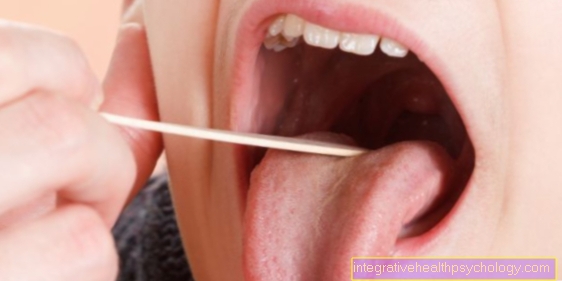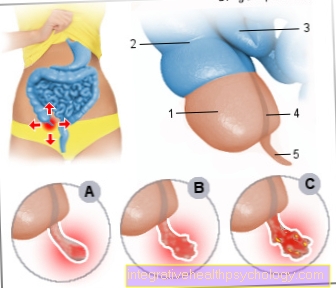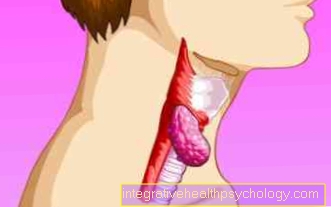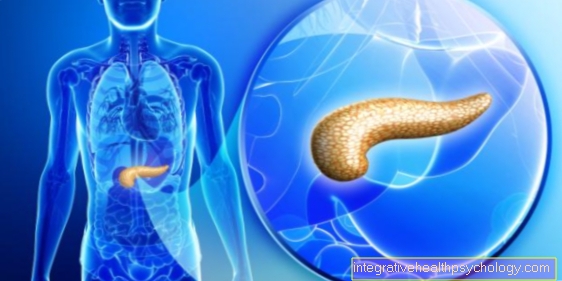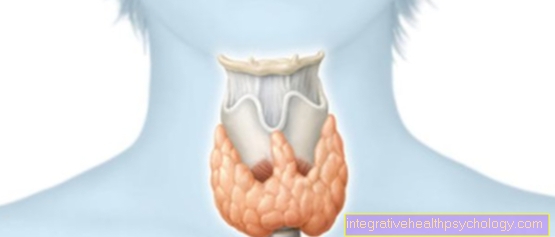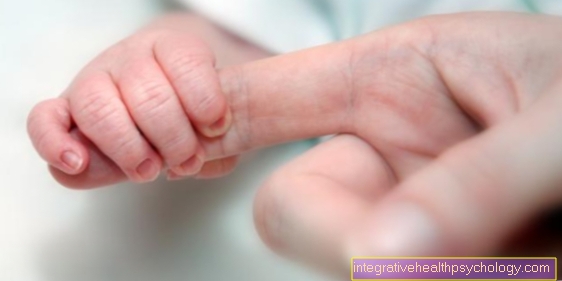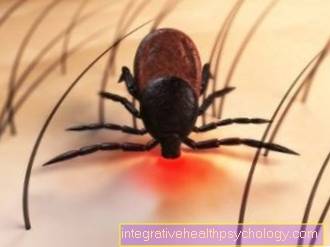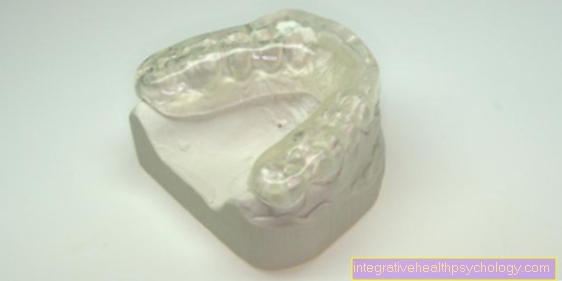Side effects of a vasectomy
introduction
In most cases, the term "vasectomy" refers to the severing of the man's vas deferens. The vasectomy is a simple surgical procedure with few complications, which leads to a very safe contraception. The number of times it is carried out is increasing; in the USA it is already one of the most frequently used contraceptive measures. In Germany, too, vasectomies are increasingly being sought, as they pose few risks compared to other contraceptive methods.
Even a reoperation with the restoration of fertility is often possible with a vasectomy.

What can be the side effects of a vasectomy?
Even if the vasectomy is a procedure with few complications, it is still an invasive surgical measure that can be associated with potential side effects. As a rule, the skin is incised on one or two places on the testicle under local anesthesia. The subsequently exposed sperm ducts of both testes are cut and a short piece is removed so that the cut ends do not grow back together. The loose ends of the vas deferens are then either obliterated with the help of electrodes, sutured with threads, or clamped with metal.
Tissue manipulation can lead to the typical side effects of invasive surgery, such as pain, bleeding, and infection. Infections can develop superficially at the skin incision or spread to the surrounding tissue. Theoretically, all complications can occur, from reddening of the skin to inflammation of the testicles. Very rarely, minor errors in the operation can lead to further complaints. If the vas deferens are not carefully differentiated and separated from the rest of the tissue, surrounding structures such as blood vessels or epididymis can be injured.
Here you can find more information on the topic: Vasectomy - The sterilization.
The pain
The most common side effect of a vasectomy is post-operative pain. Pain can arise for a number of reasons. In most cases it is a typical, harmless wound pain caused by the skin incision and the operation on the spermatic cord. Even this is relatively rare and low in vasectomy. Only about a third of patients report pain after the procedure.
Under certain circumstances, pain can also be caused by injury or inflammation of other structures in the surgical area. The pain is often delayed after a few days. Depending on the cause, other symptoms such as swelling and redness will appear.
A so-called "post-vasectomy syndrome" can also occur very rarely. This describes a prolonged state of pain, the cause of which is unknown. Probably there is also involvement of nerves or the epididymis. Those affected complain of constant pain in the surgical area that lasts for weeks.
Find out all about the topic here: Pain after a vasectomy.
Rebleeding
Occasionally, rebleeding may occur during the vasectomy. The skin incision and the cuts on the vas deferens injure and sever ever smaller blood vessels. During the operation, minor bleeding is stopped with the help of compresses or by obliterating the vessels with the help of electrodes. This minor bleeding occurs with all surgical interventions. Secondary bleeding can occur because many small blood vessels have been injured and the bleeding has not been stopped. Blood vessels that have already been sclerosed can also bleed again after the procedure.
More rarely, larger blood vessels, for example the supplying vessels of the testicle, can also be injured in the operating area. If the bleeding is not noticeable during the operation, subsequent bleeding with severe effusions and swellings can occur. If there is secondary bleeding, it is important to find out whether the bleeding can be stopped externally or whether another operation is necessary.
Initial measures are compression and cooling. The bruise may have to be removed and the damaged vessel sutured or obliterated in a new operation
The epididymis
Epididymis is the most common deep and dangerous infection after a vasectomy. The procedure itself is carried out on the vas deferens just above the epididymis, which is why the proximity of the epididymis increases the risk of injury and inflammation. The typical signs of inflammation are redness, swelling, pain and overheating. In addition, there may be a fever, burning sensation when urinating, and blood in the urine and ejaculate.
Typical of epididymitis, as differentiated from other diseases of the testicles, is the ease of pain when lifting the testicles. In most cases, the inflammation must be treated with antibiotics.
As a complication, epididymitis can lead to permanent impairment of the sperm quality, which can lead to conception problems if the vas deferens are restored later.
Read more about the topic here: The epididymis.
The inflammation of the testicles
On the other hand, testicular inflammation, also known as "orchitis", occurs much less frequently after a vasectomy. The inflammation of the testicles is similar to inflammation of the epididymis. Here, too, swelling, reddening, overheating, pain and sometimes fever and discomfort when urinating occur.
The doctor can often distinguish the two types of inflammation by the precise location of the pain and the swelling. Inflammation of the testicles can also lead to unwanted, irreversible infertility regardless of the vasectomy. In addition to antibiotic therapy, cooling can reduce swelling and pain.
Find out more about the topic here: The inflammation of the testicles.
The scar tissue
The surgical procedure is always associated with minor tissue injuries. In order to be able to expose the vas deferens, smaller incisions must also be made in the connective tissue. The body cannot fully heal these minor injuries and forms scar tissue in these areas. This rarely leads to symptoms and is not a problem.
Occasionally, however, the scar tissue may grow. Those affected often feel hard, lumpy changes above the testicle. The bulging and hard scars can cause pain when the connective tissue is pulled and growth is displaced.
Normally, you can live with the scar tissue, but in very rare cases the scar tissue has to be split and removed in a new operation.
The scar granuloma
A granuloma is a collection of benign immune cells that center on one point in an inflammatory reaction and lead to tumor-like growth. During a vasectomy, the sperm cells that emerge as part of the procedure are the main trigger for the formation of granulomas (sperm granulomas).
The immune system recognizes the sperm, which leads to a build-up of immune cells. Similar to excessive scar tissue, the granuloma can be noticed as a hardening on the spermatic cord. Those affected often fear the development of a malignant tumor. The granuloma is completely harmless apart from a potential slight tenderness and does not require treatment.
Read more on the subject at: Sperm granulomas
The vascular injury of the testicle
The vascular injury to the testicle is a very rare complication of vasectomy. The supplying blood vessels are relatively large and generally out of danger. However, if unnoticed damage and disruption of the blood supply to the testicle occur, permanent damage to the testicle can occur. In the long term, the testicle can shrink and lose its functions.
In addition to the permanent inability to conceive, this also includes the restriction of the testes' hormone production. Cardiovascular complaints or erectile dysfunction may also occur less frequently. As a rule, however, not both testicles are affected, which is why hormonal disorders are often compensated for by the neighboring testicle.
The renewed fertility
On the one hand, a vasectomy is a very safe contraceptive measure, but in exceptional cases it can still be accompanied by a renewed fertility. The vasectomy interrupts the sperm conductor for several centimeters and the ends are sutured. Under certain circumstances, however, the ends of the vas deferens can open again and grow together again. Those affected often do not notice this.
A desired renewed fertility can often be achieved again after the vasectomy. In a second operation, the vas deferens can be sutured again in a microsurgical procedure, whereby the ejaculate receives sperm again. Even after several years, fertility is still possible in the majority of cases.
For more information, read on: How can you do a vasectomy?
Is there an increased tumor risk?
The vasectomy is not associated with an immediately increased tumor risk. There is no danger to the testes or epididymis that a vasectomy poses. An association with prostate carcinoma is the only thing that is widely discussed.
Some observations suggest a potential increase in risk after a vasectomy, but various studies have found no significant association.
Is there any influence on hormone production?
The vasectomy itself does not affect the production of hormones in the testicles. The sperm in the testicles are absorbed by the body and do not pose a threat to the testicular tissue. Only in the event of major injuries to the testicles or the supplying blood vessels during the procedure, in rare cases, loss of function of the testicles can occur.
In the context of a normal vasectomy, however, there is no increased risk of long-term impaired hormone production.




